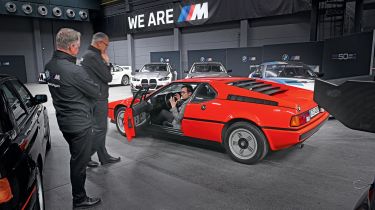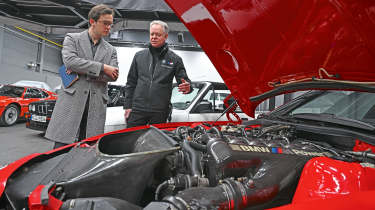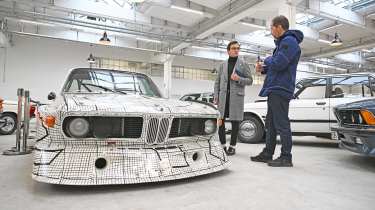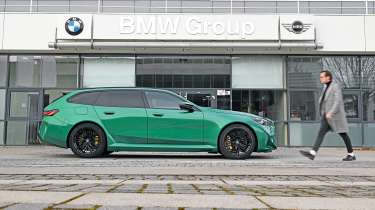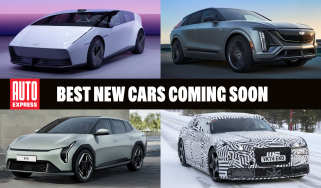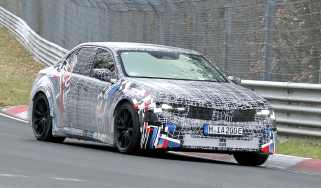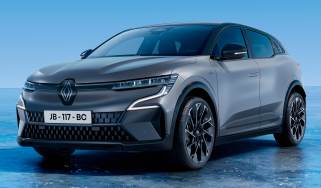What is BMW M? Past, present and future of the Bavarian powerhouse
For more than 50 years, BMW’s M division has been thrilling drivers. We look at its amazing past – and preview an exciting future
“Win on Sunday, sell on Monday” – the fabled words and mantra of Bob Tasca Sr, a Ford dealer in the sixties and creator of the Mustang Cobra Jet drag racer. It’s a philosophy that resonates with car makers to this day, but in 1972, Robert A Lutz took these American principles, learned during his time at General Motors, and applied them to his new role at BMW.
After a pivotal meeting with his fellow board members, Lutz and 34 colleagues founded the BMW Motorsport GmbH subsidiary – and unknowingly prompted the start of a cult of enthusiasts, all worshipping a single letter.
More than 50 years on, BMW M (renamed as such in 1993) is undoubtedly one of the most beloved names in the automotive industry. And during those five decades, it’s been responsible for producing and powering some of the most venerated sports cars we’ve ever seen.
To find out exactly what transformed a small spin-off into a household name, we visited the firm’s home in Munich. At the time of M’s formation, BMW had long been involved in motorsport and appeared to be going from strength to strength. In 1969, the BMW 2002 TIK was the first turbocharged car to win the European Touring Car Championship (ETCC), while in the same year, a BMW engine-powered Lola helped Hubert Hanhe secure runner’s-up spot in the Formula 2 European championship.
With a desire to claim victory in the ETCC again, BMW Motorsport’s first task was to take the 3.0 CS, the successor to the 2000 series car, and ready it for racing. The result was the 3.0 CSL, with the ‘L’ standing for ‘lightweight’. Weighing in at 200kg less than the standard car, and with an output of 203bhp, the CSL lived up to its name with a power-to-weight ratio of one horsepower per 6.1kg, which was exceptional for the time.
The car was designed just a stone’s throw away from BMW’s original manufacturing plant, which was built in 1918 and is now the home of BMW Group Classic, a facility which celebrates the history of the firm. Despite the abundance of cold concrete and steel, the building exudes a warm and spiritual aura; the light peering through the original factory windows and its echoey nature make it feel like a cathedral to the blue and white propeller.
Here, we found a particularly special version of the CSL, the one-of-one Art Car painted by Frank Stella. Very much a homologation race special to start with, Stella’s idea was to paint the CSL to appear as if it was still on graph paper in the design stage. The car itself, which made its debut at Le Mans in 1976, is perhaps the purest, most emblematic example of what the CSL truly was – and a blueprint for the fully fledged BMW M cars that were to come.
The first model to get the proper ‘M’ designation was the M1 supercar in 1978. Codenamed E26 behind the scenes, the M1 was the result of a failed collaboration between BMW and Lamborghini. With a mid-engine layout and an ultra-lightweight fibreglass body penned by legendary designer Giorgetto Giugiaro, the M1 was used in the Procar series, which saw Formula One drivers pitted against professional and private racers from other championships.
This symbiotic relationship with motorsport has continued ever since. The E30 M3, for example, was built as a homologation special and became arguably the most successful touring car of all-time. Even today, BMW's
M cars are developed in the same workshop as their GT3 and GT4 racing counterparts, literally metres away from each other.
Since the M1, every M model produced has been based on an existing Series car, bar the recent XM hybrid super-SUV. As Dirk Häcker, BMW M’s head of engineering, acknowledges: “If there was ever another M halo car like the M1, I’m sure there would be a lot of interest.”
But what is it that makes M such an appealing brand to buyers? It certainly resonates with drivers in the UK, because BMW tells us that one in 10 of new cars ordered by British buyers are in either M Performance or full-fat M guise.
Hans Rahn, M’s head of prototype construction, has a simple answer for this. According to Rahn, it’s because “BMW M is a community of maniacs!”. This might sound like corporate hyperbole, but Rahn’s theory is quickly verified as soon as you start poking around BMW’s own private car collection.
For example, one thing that immediately catches our eye is a one-off pick-up version of the E30 M3. This, explains Rahn, was the result of an experiment by apprentices at BMW M who were tasked to build a sporty transport vehicle for use within the development centre.
Then there’s the M8 prototype of the Nineties, which was produced as a rebuttal to criticism that the standard 8 Series was too soft to be a driver’s car. Comparable with handing a seven-year-old some crayons and telling them to go wild, the team delivered an array of improvements including swapping the standard 8’s comfortable leather seats for Recaro buckets, and the glass for Lexan-style panels. Perhaps most impressive, however, was its bespoke 6.0-litre V12 which largely formed the basis of the one used in the McLaren F1. “The initial question on these projects is always: ‘Will it fit?’,” laughs Rahn.
But M’s appeal is a lot more than just its ragtag group of mad-scientist engineers. As Rahn explains: “M cars get into your central nervous system. They’re emotional.”
Such a compliment is difficult to dispute for older models, thanks to their hydraulic power steering, low kerb weights and sonorous engines not stifled by emissions regulations. However, even in the latest BMW M5, despite it weighing a frankly paunchy two-and-a-half tonnes, the boffins at M have worked their magic to make it feel almost as agile and enjoyable to drive as its predecessors.
Yet, as we approach an age of increasingly electrified and digitised performance models, there is a fear that such emotion could be lost. Thankfully, models such as the Hyundai Ioniq 5 N and Porsche Taycan have shown that electric vehicles can still be an attractive proposition to car enthusiasts.
With M’s first electric car on the horizon, coming in the form of the quad-motor iM3, it is picking up the baton, with Häcker claiming “it’s good to be a fast follower”. He explains how “anything in a car can ignite you, be it sound, vibrations or the way a car responds to you”.
Several EVs, such as the Abarth 500e, have experimented with augmented sounds, but Rahn says that “while one of the major challenges of EVs is maintaining a sense of tactility, just playing a V8 engine sound doesn’t make sense”.
The division's prototype construction boss continues: “Electric motors have a very specific sound and we can enhance the best parts of that whilst also simulating gearshifts.”
Despite the iM3 potentially having more than 1,000bhp, Häcker reminds us how “you need good acceleration, but you don’t need to be the fastest”. He adds: “We’re focusing more on producing emotion on, say, a mountain road.”
To enable the development of both ICE and electric cars, the team at M has grown by approximately 20 per cent to around 1,000 employees in the past three years. Yet there is still a sense of intimacy about the operation; M’s development centre remains self-contained, working physically alongside not only the motorsport division, but also BMW Individual – the Munich firm’s bespoke service.
There’s no denying that M’s first foray into the realm of EVs is a crucial moment for the brand; Häcker admits to us: “There’s a certain pressure when building the first M car. We have high requirements of our own and are highly motivated to fulfil the expectations of the customer.”
Yet it’s worth noting how this switch to electric has forced M to go back to its roots by implementing the latest technology to not necessarily innovate, but instead perfect the formula for the ideal driver’s car. M has often been called the ‘most powerful letter in the world’, but only time will tell whether BMW can spread its core DNA through a bloodline of “emotional” electric performance cars.
What was the first M car?
BMW automotive and racing historian Marc Thiesbürger says three models could be considered the first M car.
One is the 3.0 CSL, which was the maiden project the M team, then called BMW Motorsport GmbH, worked on.
The next is the slightly lesser-known 530 MLE, which was built to compete in South Africa’s Modified Production racing series. Based on the E12 5 Series of the seventies, the MLE was the first car to bear the ‘M’ nameplate, with only 100 examples being produced.
Finally, there’s the M1 which, if you ask Thiesbürger, is the true first M car. That’s because “unlike those that came before it, it was a serial production car” – even though only 460 were made.
BMW’s art and soul?
The firm’s famous Art Cars and the M division are closely linked. In 1975, French racing driver Hervé Poulain expressed a desire for ‘moving art’ on the racetrack, so over lunch and wine, convinced painter Alexander Calder to design a bespoke livery for his 3.0 CSL.
Since then, the likes of David Hockney, Frank Stella, Roy Lichtenstein and Jeff Koons have taken part in the ongoing BMW Art Car project. Perhaps the most famous example is the M1 Group 4 racer painted by Andy Warhol which is, to this day, the only car to be physically painted by the artist themself.
How M got its colours
Did you know that there’s actually a story behind the familiar BMW M colours? Back in the early seventies, BMW tried to get Texaco on board as a sponsor for its racing efforts.
BMW Classic’s spokesperson Marc Thiesbürger tells us that it’s thought the red was used to try to “win over” Texaco in the agreement – but the proposed deal fell through. M decided to keep the colour red as part of its livery, changing its meaning to represent “motorsport”.
The light blue has always been a nod to BMW’s Bavarian home, and the violet “the unique combination of the two” that became a signature paintjob.
Buy a car with Auto Express. Our nationwide dealer network has some fantastic cars on offer right now with new, used and leasing deals to choose from...
Find a car with the experts

